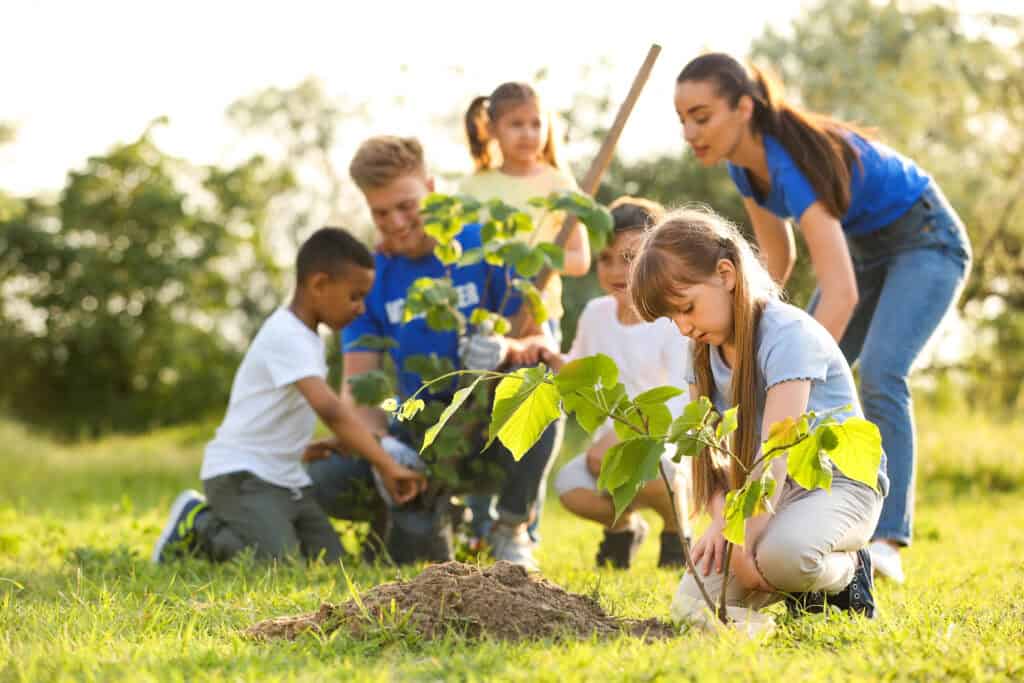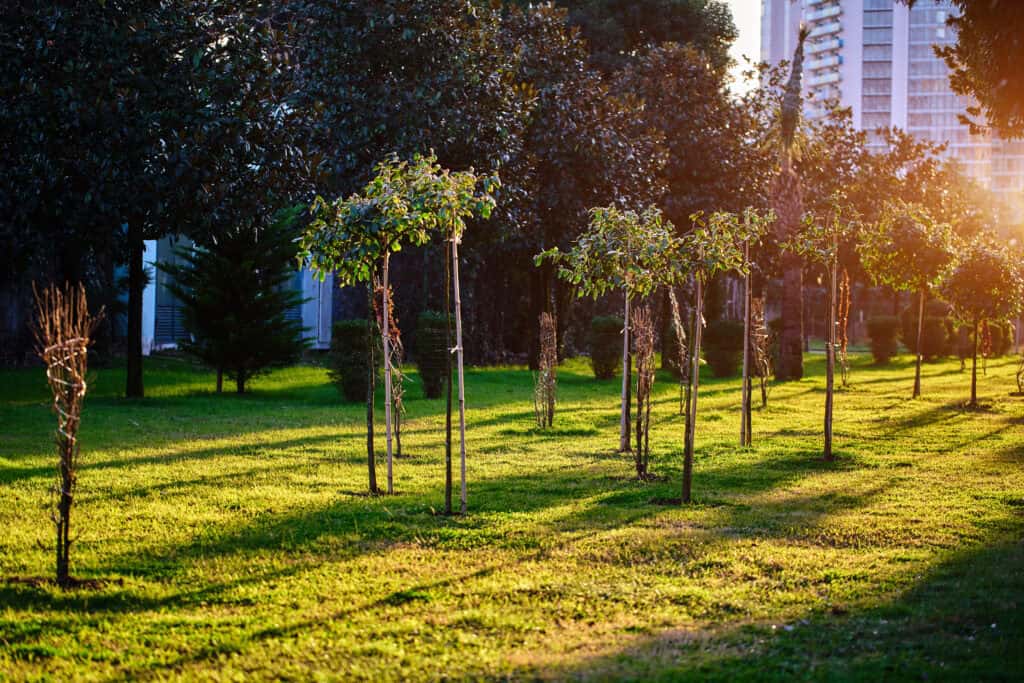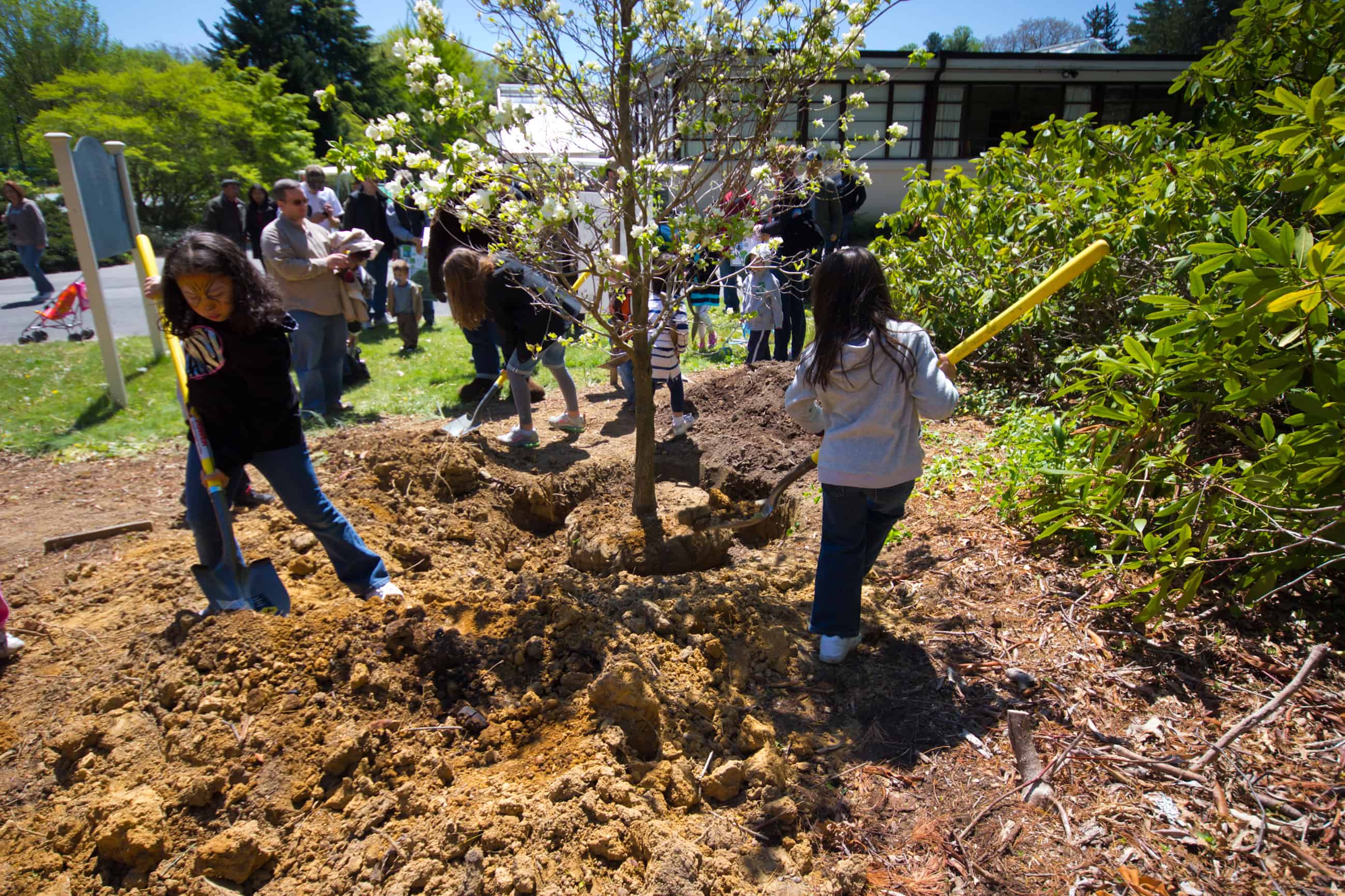Planting trees plays a crucial role in mitigating the effects of extreme heat and air pollution, especially in urban areas. As cities continue to grow and develop, they often become “heat islands,” trapping heat due to the abundance of concrete and asphalt surfaces. Trees provide natural shade and cooling through evapotranspiration, reducing surface temperatures and helping to alleviate the heat island effect. By creating cooler microclimates, trees can enhance the comfort of urban residents during hot weather.
On an 80 degree day, unshaded synthetic surfaces, such as asphalt, rubberized mulch and synthetic turf can rise to over 120 degrees, potentially burning those playing on them, and increasing the surrounding atmospheric temperature. Vegetation and tree canopies lower temperatures through direct shade and a process known as evapotranspiration, in which trees pull moisture from the soil and release it via leaves. An area of shade can be 20 to 45 degrees cooler than surfaces in full sun, according to the U.S. Environmental Protection Agency.

In addition to combating extreme heat, trees act as natural air filters, helping to improve air quality and reduce pollution levels. Through the process of photosynthesis, trees absorb carbon dioxide, ozone, and other harmful pollutants from the air, while releasing oxygen. This filtration process helps to remove pollutants that can contribute to respiratory illnesses and other health problems. By planting trees strategically in urban areas, especially on schools grounds, communities can effectively reduce air pollution, creating cleaner and healthier environments for residents to live, work, and play.
Furthermore, trees play a vital role in promoting biodiversity and supporting ecosystems. Urban green spaces provide habitat for birds, insects, and other wildlife, contributing to urban biodiversity and ecological resilience. By planting a diverse range of tree species, schools and cities can create vibrant green corridors and wildlife habitats that enhance urban biodiversity and support ecosystem services such as pollination and soil stabilization. Natural surfaces and trees also lower the amount of water used and increase the amount of water stored in the ground, making areas with trees more drought resistant.
Research shows that urban tree and shrub cover in schools is positively associated with increased physical activity, attention and social collaboration, as well as higher academic performance, as well as student’s decreases in stress, anxiety and disruptive behavior. The choices schools and districts make about how they manage their land directly impacts students’ daily experiences, mental and physical health, and learning outcomes.
Overall, investing in tree planting initiatives builds sustainable and resilient cities that provide multiple benefits for both people and the planet.
Join us in making every tree count – start your tree planting journey today!

Tree Growing Tips
Selecting and Planting
1. Choose a tree species that is suitable for your climate, soil type, and the location where you plan to plant it. Consider the tree’s mature size and ensure it has enough space to grow.
2. Pick a well-draining location with adequate sunlight. Remove any grass, weeds, or debris from the planting area.
3. Dig a hole that is two to three times wider than the root ball of the tree and just as deep. This allows the roots to spread out more easily.
4. If the tree is in a container, gently remove it. Loosen the roots if they are tightly wound. If the tree is balled and burlapped, remove any wire, string, and burlap from the root ball.
5. Place the tree in the hole, ensuring that the root flare (where the roots spread at the base of the tree) is at ground level or slightly above. The tree should stand straight.
6. Fill the hole with the soil you removed, breaking up any large clumps. Gently tamp the soil to remove air pockets. Water the soil as you fill the hole to help settle it around the roots.
7. Build a small berm (a raised ring of soil) around the tree at the edge of the planting hole. This will create a basin to hold water and allow it to soak into the soil around the roots.
Watering
Young Trees (0-3 Years Old): Water young trees 2-4 times per week, depending on weather conditions and soil type. Each watering should provide about 5 gallons of water. – **Method:** Fill a 5-gallon bucket with a small hole near the bottom, place it near the tree, and let it slowly drain into the soil. Alternatively, use a hose with a slow trickle to fill the watering basin.
Mature Trees (3+ Years Old): Water mature trees deeply once a month during dry months. Adjust frequency based on the species and local weather conditions. Soak the root zone out to the drip line (the area under the farthest reaches of the branches) until the water penetrates 12-18 inches below the surface. Use a soaker hose or sprinkler attachment on a low setting. If using a drip system, ensure it is functioning properly and covers the root zone adequately. Check soil moisture by inserting a screwdriver or soil probe at least 6 inches below the surface near the drip line. If the soil is hard and dry, water slowly until moist. If the soil is wet, allow it to dry before watering again.
To avoid roots rotting, do not overwater or water close to the trunk. Water early in the morning or late in the evening to minimize evaporation.
Mulching
Apply a 4-6 inch layer of organic mulch, such as wood chips or leaf matter, in a 4-foot diameter around the tree, keeping it 6 inches away from the trunk. Mulch helps retain moisture, protect roots, and regulate soil temperature. Do not place rocks, weed fabric, or artificial turf at the base of the tree, as they increase water runoff and trap heat.
Pruning
Pruning trees is essential for maintaining their health, safety, and aesthetics. It involves removing dead, damaged, or diseased branches to prevent decay and promote healthy growth. Pruning also enhances air circulation and sunlight penetration, reducing the risk of fungal infections and pest infestations. It is important to prune at the right time of year, typically during the dormant season, to minimize stress on the tree. Avoid pruning in the dry season. Proper pruning techniques, such as making clean cuts just outside the branch collar and avoiding excessive removal of live branches, help ensure the tree’s long-term vitality and structural integrity.

California School Tree Planting
A recent report of California schools showed that 85% of schools have less than 10% shade covering. Children spend a significant portion of their day at school or daycare. Removing synthetic surfaces that absorb heat and adding shade trees in places that are accessible to children during the school day will directly protect them from high temperatures and toxic air exposure. This is especially true for children in daycare or pre-school who are closer to the hot ground.
Communities with the fewest resources usually have the least access to nature within and surrounding their school grounds, coupled with the highest pollution/environmental toxicology levels. Researchers conclude that vegetative barriers can act in two ways against pollution, such as car exhaust: directly blocking it, and also absorbing it. It’s possible that up to 50% of particulate matter could be reduced after trees grow to maturity.
Students’ daily school experiences, mental and physical health, and learning outcomes are impacted directly by their environment and nature on their school campus. On-campus green space designs have environmental and ecological resilience benefits, such as composting, stormwater management, rainwater collection, carbon and runoff sequestration and air quality improvement. Removing pavement, asphalt, synthetic surfaces, including synthetic turf, and adding shade trees in places that are accessible to children and youth during the school day directly protects children from high temperatures and reduces urban heat islands in the surrounding community, while also making school grounds more comfortable for both children and adults.
Local California Community Resources
If your city or county are not listed below, try typing them into a search followed by “Free Trees”. If you find additional cities, counties or organizations offering free trees, please email info@nontoxicschools.org so we can add them to this list…
National Program
National Wildlife Federation keeps an updated list of federal and state grants and programs that give away trees – https://www.nwf.org/Trees-for-Wildlife/Request-Trees
Northern California (Free) Tree Planting Programs
City of Mountain View Free Tree Giveaway – https://www.mountainview.gov/our-city/departments/community-services/urban-forest/arbor-day-tree-giveaway-program
Central and East City of San Jose, Alviso, Gilroy, Morgan Hill, Milpitas, and other additional areas: https://www.ourcityforest.org
City of Oakland: https://www.treesforoakland.org/how-to-get-a-tree.html
City of Seaside: https://www.ci.seaside.ca.us/785/TREE-GIVEAWAY—2024-program-will-open-i
City of Salinas: https://www.cityofsalinas.org/Your-Government/Find-a-Department/Public-Works/Urban-Forest/Free-Trees
City of San Francisco: https://www.friendsoftheurbanforest.org/adopt-a-yard-tree
City of Sacramento: https://sactree.org/programs/free-shade-trees/
Southern California (Free) Tree Planting Programs
SoCal WaterSmart Free Tree Program: https://socalwatersmart.com/en/tree-rebate/
City of Glendale: https://www.glendaleca.gov/government/departments/glendale-water-and-power/residential-customers/residential-programs/tree-power-free-shade-trees
City of Los Angeles: https://www.cityplants.org/our-programs/ and https://www.kyccla.org/services/environmental-services/free-trees-2/
Los Angeles County: https://planning.lacounty.gov/blog/free-trees/
City of Long Beach: https://www.longbeach.gov/sustainability/programs/tree-planting/
City of Anaheim: https://www.anaheim.net/763/Residential-TreePower
City of Escondido: https://library.escondido.org/627/Request-a-Free-Tree
Cities of San Diego, San Gabriel Valley, Santa Monica, Palm Springs and Palmdale: https://www.bewaterwise.com/tree-rebates.html
City of San Diego: https://www.sandiego.gov/form/request-free-tree-sd and https://www.sdge.com/trees/community-tree%20programs

